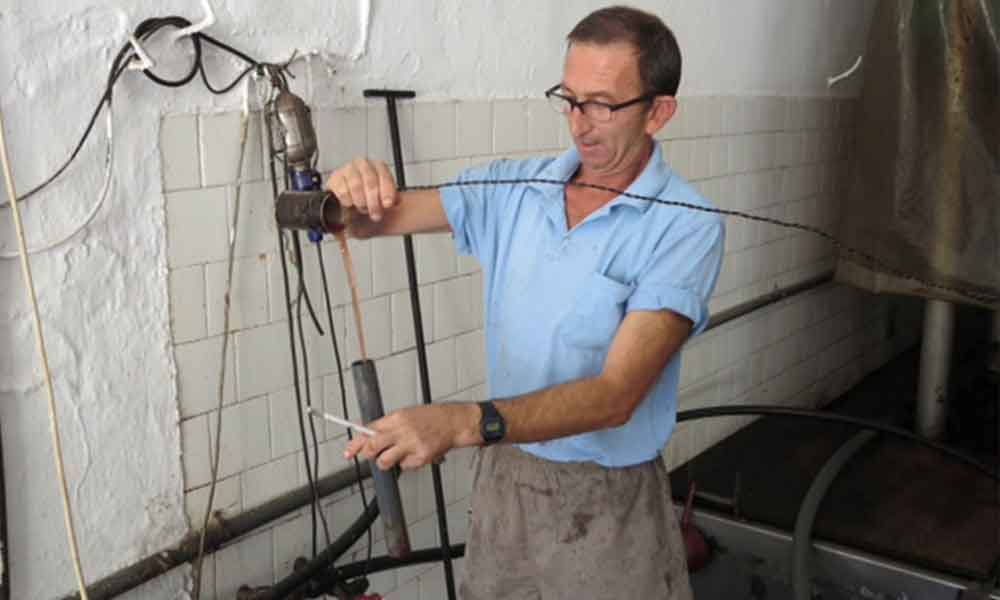-
14
Jan 2016
The traditional preparation of Vino del Terreno

This year in September I traveled again through the Axarquía, a region east of Malaga I know and love very much. It struck me that despite the heat waves of August, the landscape was still green and the gardens were beautiful with colorful flowers and many fruits. There was an abundance of citrus fruits, mangoes and of course olives. The many vines were covered with huge bunches of grapes. These vine tendrils of Muscat grapes bear fruit from April and are well matured by September. The sweet fruit is perfect for making a delicious dessert wine, in this area called el Vino del Terreno. In September many of the local landowners are busy bringing in the harvest before the birds can feast on the grapes. This harvest can be a daunting task, especially if there are many vines and if the slope of the land is very steep which it often is.
My friends from Second Home Andalusia have invited (or challenged) me to help lend a hand with the grape harvest in a small vineyard in Velez Malaga. We would follow the complete process from the pressing of the grapes to making the wine. I decided to take up the challenge despite the fact I had to get up at the crack of dawn! The harvest went well, many hands made light work.
We had to pick not only the good grapes but also the bunches that were overripe along with grapes that have started to dry out. The overripe grapes, where the rotting process is already underway, and the dried grapes are essential for the wine because they contain the highest level of sugar, giving the dessert wine 'its sweetness’. In only a few hours we had harvested about 220 kilos of grapes. After crushing, the total weight would result in around 180 liters of dessert wine!
Along with our boxes of grapes, we drove to Algarrobo to el Fábrica de Aceite El Molino, a factory that, since 1840, have pressed olives and made olive oil (aceite) in the traditional way. These presses are also suitable for pressing grapes, although the pressing process is of course different. This process that I have followed with great fascination is so traditional, it appeared to me as if it was almost medieval.
Here is the procedure we followed in El Molino: After our arrival we put all our kilos of grapes on a kind of platform and then they were emptied into a big bin where they were ground up into a green pulp. The slurry was poured on to mats, called ‘Capachos', which were piled around a pole.
 © Jan van der Marel, 2015
© Jan van der Marel, 2015
The mats, which resembled a large stack of pancakes, supported by their weight on each other and were already creating a good flow. After all the pulp was collected on the slabs, the whole amount was put in the press and immediately it produced a real waterfall of grape juice into the tank. With excitement we watched it gradually fill up and eventually the dipstick read approximately 175 liters.
 © Jan van der Marel, 2015
© Jan van der Marel, 2015
Now we wanted to know how high the sugar content of the wine would be. A very sweet dessert wine has about 20 degrees Brix, which means that 100 ml juice contains 20 grams of sugar. We all made a guess how sweet the wine would be before the owner of El Molino did his test. With a small cup he took a sample of wine and poured it into a length of PVC pipe. Then he dipped the Brix meter in the pipe and it read 15 degrees; compared with last year's harvest it was a little less sweet. The next part of the process was to fill our wine containers that we had brought with us which reminded me of filling our jerry cans at the petrol station. Satisfied and proud we drove home, our car laden with our own Vino del Terreno.
Shortly after our arrival we made a toast, with a delicious dessert wine from last year, to a very successful and informative day. Obviously it was not with today´s 'production' as this needs a fermentation time of at least six weeks. I am already looking forward to my next visit in the beginning of the new year because I can´t wait to taste this wine too!
Hasta pronto, y un saludo cordial de Jeanette,
friend of Team Second Home Andalusia



